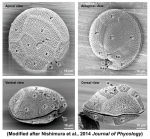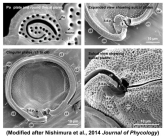WoRMS taxon details
Gambierdiscus scabrosus T.Nishimura, Shinya Sato & M.Adachi, 2014
833060 (urn:lsid:marinespecies.org:taxname:833060)
accepted
Species
marine
Nishimura, T., Sato, S., Tawong, W., Sakanari, H., Yamaguchi, H., Adachi, M. (2014). Morphology of Gambierdiscus scabrosussp. nov. (Gonyaulacales): A new epiphitic dinoflagellate from coastal areas of Japan. <em>Journal of Phycology.</em> 50, 506-514., available online at https://doi.org/10.1111/jpy.12175 [details]
Description Cells of G. scabrosus are photosynthetic, anterioposteriorly compressed, depth 63.2 ± 5.7 μm, width 58.2 ± 5.7 μm,...
Description Cells of G. scabrosus are photosynthetic, anterioposteriorly compressed, depth 63.2 ± 5.7 μm, width 58.2 ± 5.7 μm, and length 37.3 ± 3.5 μm. Cell lenticular, round to ellipsoid in apical view. The thecal surface is areolated. Thecal pores are numerous, round with a smooth edge. Flagella 2. Plate formula is Po, 4', 0a, 6'', 6c, ?s, 5''', 0p, and 2''''. In epitheca, the apical pore plate is elliptical, with about 29 pores and a large fishhook-shaped opening. The 2' plate is the largest of apicals and is rectangular, the 3' plate is median and is pentagonal, and the 4' plate is small and is hexagonal. The 1' plate is the smallest of apicals. The 2'' and 3'' plates are large, the 1'', 4'', and 5'' plates are intermediate, and the 6'' plate is minuscule, lying adjacent to the sulcus and posterior to the 4' plate. The 3'' plate is asymmetrical. The cingulum is narrow and deeply excavated. The sulcus is deep and pouchlike. In hypotheca, the 1''' and 5''' plates are small, the 2''' and 3''' plates are intermediate, and the 4''' plate is the largest of postcingulars. The 2'''' plate is intermediate, narrow, and pentagonal. The 1'''' plate and posterior sulcal plate (S.p.) are small. The nucleus is located on the dorsal side in hypotheca and is U-shaped with points towards the ventral side. [details]
Guiry, M.D. & Guiry, G.M. (2024). AlgaeBase. World-wide electronic publication, National University of Ireland, Galway (taxonomic information republished from AlgaeBase with permission of M.D. Guiry). Gambierdiscus scabrosus T.Nishimura, Shinya Sato & M.Adachi, 2014. Accessed through: World Register of Marine Species at: https://www.marinespecies.org/aphia.php?p=taxdetails&id=833060 on 2024-06-08
Date
action
by
Copyright notice: the information originating from AlgaeBase may not be downloaded or replicated by any means, without the written permission of the copyright owner (generally AlgaeBase). Fair usage of data in scientific publications is permitted.
original description
Nishimura, T., Sato, S., Tawong, W., Sakanari, H., Yamaguchi, H., Adachi, M. (2014). Morphology of Gambierdiscus scabrosussp. nov. (Gonyaulacales): A new epiphitic dinoflagellate from coastal areas of Japan. <em>Journal of Phycology.</em> 50, 506-514., available online at https://doi.org/10.1111/jpy.12175 [details]
basis of record Guiry, M.D. & Guiry, G.M. (2024). AlgaeBase. <em>World-wide electronic publication, National University of Ireland, Galway.</em> searched on YYYY-MM-DD., available online at http://www.algaebase.org [details]
toxicology source Nishimura, T., Sato, S., Tawong, W., Sakanari, H., Yamaguchi, H., Adachi, M. (2014). Morphology of Gambierdiscus scabrosussp. nov. (Gonyaulacales): A new epiphitic dinoflagellate from coastal areas of Japan. <em>Journal of Phycology.</em> 50, 506-514., available online at https://doi.org/10.1111/jpy.12175 [details]
basis of record Guiry, M.D. & Guiry, G.M. (2024). AlgaeBase. <em>World-wide electronic publication, National University of Ireland, Galway.</em> searched on YYYY-MM-DD., available online at http://www.algaebase.org [details]
toxicology source Nishimura, T., Sato, S., Tawong, W., Sakanari, H., Yamaguchi, H., Adachi, M. (2014). Morphology of Gambierdiscus scabrosussp. nov. (Gonyaulacales): A new epiphitic dinoflagellate from coastal areas of Japan. <em>Journal of Phycology.</em> 50, 506-514., available online at https://doi.org/10.1111/jpy.12175 [details]
From regional or thematic species database
Description Cells of G. scabrosus are photosynthetic, anterioposteriorly compressed, depth 63.2 ± 5.7 μm, width 58.2 ± 5.7 μm, and length 37.3 ± 3.5 μm. Cell lenticular, round to ellipsoid in apical view. The thecal surface is areolated. Thecal pores are numerous, round with a smooth edge. Flagella 2. Plate formula is Po, 4', 0a, 6'', 6c, ?s, 5''', 0p, and 2''''. In epitheca, the apical pore plate is elliptical, with about 29 pores and a large fishhook-shaped opening. The 2' plate is the largest of apicals and is rectangular, the 3' plate is median and is pentagonal, and the 4' plate is small and is hexagonal. The 1' plate is the smallest of apicals. The 2'' and 3'' plates are large, the 1'', 4'', and 5'' plates are intermediate, and the 6'' plate is minuscule, lying adjacent to the sulcus and posterior to the 4' plate. The 3'' plate is asymmetrical. The cingulum is narrow and deeply excavated. The sulcus is deep and pouchlike. In hypotheca, the 1''' and 5''' plates are small, the 2''' and 3''' plates are intermediate, and the 4''' plate is the largest of postcingulars. The 2'''' plate is intermediate, narrow, and pentagonal. The 1'''' plate and posterior sulcal plate (S.p.) are small. The nucleus is located on the dorsal side in hypotheca and is U-shaped with points towards the ventral side. [details]Harmful effect The Mouse bioassay revealed that G. scabrosus showed both dichloromethane soluble fraction (a fraction expected to contain CTXs) toxicity and aqueous methanol soluble fraction (a fraction expected to contain MTXs) toxicity (Nishimura et al. 2013).Strains also test positive to the Neuro-2a cell binding assay (Pisapia et al. 2017). [details]
Identification Litaker et al. (2009) proposed the useful diagnostic characteristics at the rank of species of Gambierdiscus, namely, the 2'''' plate (considered as 1p plate in Faust 1995, Chinain et al. 1999, and Litaker et al. 2009) and 2' plate in the hypotheca and the epitheca respectively. The 2'''' plates in the hypotheca of G. australes, G. belizeanus, G. pacificus, and G. scabrosus are narrow, whereas those of G. caribaeus, G. carolinianus, G. carpenteri, G. polynesiensis, and G. toxicus are broad. Two groups, narrow and broad 2'''' plate, could also be discriminated by plate morphometry, that is, the ratio of L to W of the 2'''' plate is on average 2.15 in the narrow group (1.83: G. belizeanus, 2.00: G. australes, 2.18: G. scabrosus, and 2.57: G. pacificus as measured by SEM, whereas the ratio is 1.48 on average in the broad group (1.26: G. caribaeus, 1.38: G. polynesiensis, 1.51: G. toxicus, 1.60: G. carpenteri, and 1.65: G. carolinianus as measured by SEM. The 2' plates in the epitheca of G. toxicus, G. pacificus, G. carolinianus, and G. belizeanus are hatchet shaped, whereas that of G. australes, G. caribaeus, G. carpenteri, and G. scabrosus are rectangular shaped. Two groups, hatchet and rectangular, could also be discriminated by plate morphometry, that is, the ratio of the plate border of the 2' plate with respect to the 1'' plate (considered as 2'' plate in Faust 1995, Chinain et al. 1999, and Litaker et al. 2009) and 3'' plate (considered as 4'' plate in Faust 1995, Chinain et al. 1999, and Litaker et al. 2009) is on average 0.54 in the hatchet group (0.36: G. pacificus, 0.63: G. carolinianus, and 0.64: G. belizeanus as measured by LM (table 7 in Litaker et al. 2009), whereas the ratio is 0.85 on average in the rectangular group (0.69: G. australes, 0.85: G. scabrosus, 0.91: G. caribaeus, and 0.93: G. carpenteri as measured by LM. In the epitheca, Litaker et al. (2009) proposed that the 3'' plate (considered as 4'' plate in Faust 1995, Chinain et al. 1999, and Litaker et al. 2009) was also the useful diagnostic characteristic between G. caribaeus and G. carpenteri, namely, the shape of the 3'' plate of the former is symmetric, whereas that of the later is asymmetric (fig. 10 in Litaker et al. 2009). In the cases of G. scabrosus and G. belizeanus, the two species could also be discriminated by plate morphometry of the 3'' plate, that is, the ratios of the plate border of the 3'' plate with respect to the 2'' and 4'' plates for G. scabrosus is 0.70 (asymmetric), whereas the ratios for G. belizeanus is 1.01 (symmetric) as measured by LM. [details]



